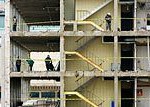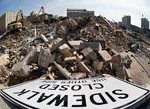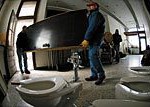Tag Campus facilities & construction
Utility construction to begin near Library Mall
A new phase of underground utility construction is expected to begin on Library Mall this week in an effort to improve the campus infrastructure.
Recent sightings: Peterson demolition
The Peterson Office Building is transformed into a cutaway skeletal shell as deconstruction crews continue dismantling panels of the structure on June 25,…
Town hall meeting set on study of state-owned heating and cooling plants
A town hall meeting detailing the progress of a study on state-owned heating and cooling facilities in Madison will be held Tuesday, June 17, from 5:30-8:30 p.m. in the Mechanical Engineering Building at the University of Wisconsin–Madison.
Busy summer ahead for construction projects
The campus' pace may be slowing with the coming of summer, but the sounds of jackhammers, heavy equipment and busy construction crews show that University of Wisconsin–Madison improvements are going full-steam ahead.
Mechanical Engineering Building project wins preservation award
The addition to the 78-year-old Mechanical Engineering Building at the University of Wisconsin–Madison won an award from the Madison Trust for Historic Preservation at its annual awards ceremony this week.
Recent sightings: Rubble-rousers
Construction workers use heavy-duty moving equipment to remove rubble — all that remains of aged and now demolished buildings once standing along…
‘Mini conference’ on Wisconsin Union Initiative set for Feb. 25
The Wisconsin Union announces a “mini conference” to formally kick off the start of the Wisconsin Union Initiative, a project to build a new “green” south campus union and restore and upgrade Memorial Union.
Extra workers sought to fight snow on UW–Madison campus
Record-setting snowfalls could translate into extra cash for University of Wisconsin–Madison students and others hired to help clear campus sidewalks and stairs of snow and ice.
Recent sightings: So much for privacy
Photo: Jeff Miller Habitat for Humanity Restore volunteers Vince Perkins and Bill Bumby (wearing red hat) remove…
Town hall meeting set on state-owned heating, power plants in Madison
The state Department of Administration and the University of Wisconsin–Madison are holding a town hall meeting on Thursday, Feb. 21, to help develop the scope for a comprehensive feasibility study to analyze the way the state heats and cools state agency buildings and the UW–Madison campus.
University addresses snow removal issues
Following is a letter from Alan Fish, associate vice chancellor for facilities, regarding the university’s work on snow removal around campus.
Campus learns about building plans at town hall meetings
Throughout the month of October, the UW–Madison and the Wisconsin Alumni Research Foundation hosted a series of town hall meetings on campus to inform the university community about the latest building plans for the Wisconsin Institutes for Discovery.
Work begins on future site of Wisconsin Institutes for Discovery
A major change will begin to take shape on the University of Wisconsin–Madison campus this month as construction begins at the future site of the Wisconsin Institutes for Discovery.
Settlement prompts heating plant improvements
A legal settlement between the state and an environmental group will result in less coal being burned at the Charter Street Heating Plant and sets the stage for major improvements at the facility.
Statement on federal court consent decree on Charter Street Heating Plant
Here is a statement from Alan Fish, associate vice chancellor for facilities at the University of Wisconsin–Madison, regarding today's (Monday, Nov. 26) agreement regarding the Charter Street Heating Plant.
New mechanical engineering building set for generations of innovation
When the Mechanical Engineering Building on the University of Wisconsin–Madison campus opened its doors in 1930, sliding chalkboards and concrete floors were among its most innovative features.
Public invited to see building plans at Chazen town hall meeting
The Chazen Museum of Art invites the community to a town hall meeting to view plans for the museum’s building expansion.
Microbial Sciences Building designed for discovery, collaboration
As the doors swung open at the new Microbial Sciences Building at the University of Wisconsin–Madison, students and researchers found a facility designed to spark exchanges of ideas aimed at answering biological questions of unprecedented complexity and importance.
Research and instruction in the Microbial Sciences Building
The University of Wisconsin–Madison Microbial Sciences Building will be home to a wide range of departments, programs and researc h centers.





